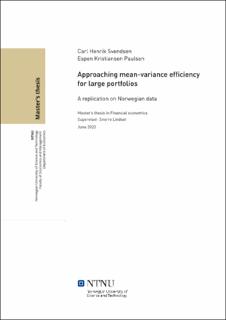| dc.contributor.advisor | Lindset, Snorre | |
| dc.contributor.author | Svendsen, Carl Henrik | |
| dc.contributor.author | Paulsen, Espen Kristiansen | |
| dc.date.accessioned | 2020-07-07T16:09:59Z | |
| dc.date.available | 2020-07-07T16:09:59Z | |
| dc.date.issued | 2020 | |
| dc.identifier.uri | https://hdl.handle.net/11250/2661310 | |
| dc.description.abstract | Denne masteroppgaven replikerer metoden til for å sette sammen optimal mean-variance porteføljer på det Norske aksjemarkedet. Deres modell, kalt maximum-Sharpe-ratio estimated and sparse regression (MAXSER), avhenger av en ny og ubegrenset regresjonspresentasjon av mean-variance problemet. Deres funn viser at modellen har økonomiske fordeler over tidligere modeller, og er i stand til å effektivt kontrollere for risiko. Vår estimerte portefølje som er basert på det Norske aksjemarkedet klarer ikke å oppnå maksimum forventet avkastning, og er heller ikke i stand til å effektivt kontrollerer for risiko. Imidlertid, når antall aksjer og observasjoner øker evner modellen bedre å kontrollere for risiko, samt og oppnå den maksimum forventede avkastningen. Våre funn blir demonstrert gjennom både simulering og empirisk analyse. Videre finner vi at å investere i individuelle aksjer i tillegg til Fama-French sin tre-faktor-portefølje øker prestasjonen betraktelig. | |
| dc.description.abstract | This master thesis replicates the approach by Ao et al. (2018)to construct optimal mean-variance portfolios on the Norwegian stock market. Their model, which they call the maximum-Sharpe-ratio estimated and sparse regression (MAXSER) method, relies on a novel unconstrained regression representation of the mean-variance problem. Their findings show the model offering an advantage over previous models and is able to effectively control for risk. However, based on the Norwegian stock market our estimated portfolio does not attain the maximum expected returns, and is not able to effectively control for risk. However, when the number of assets and observations increase, the ability of the model to control for risk and attain the maximum expected returns increases. These findings are demonstrated through simulation and empirical analysis. We also find that when investing in individual stocks in addition to the Fama-French three-factor portfolios, the performance is improved. | |
| dc.publisher | NTNU | |
| dc.title | Approaching mean-variance efficiency for large portfolios | |
| dc.type | Master thesis | |
